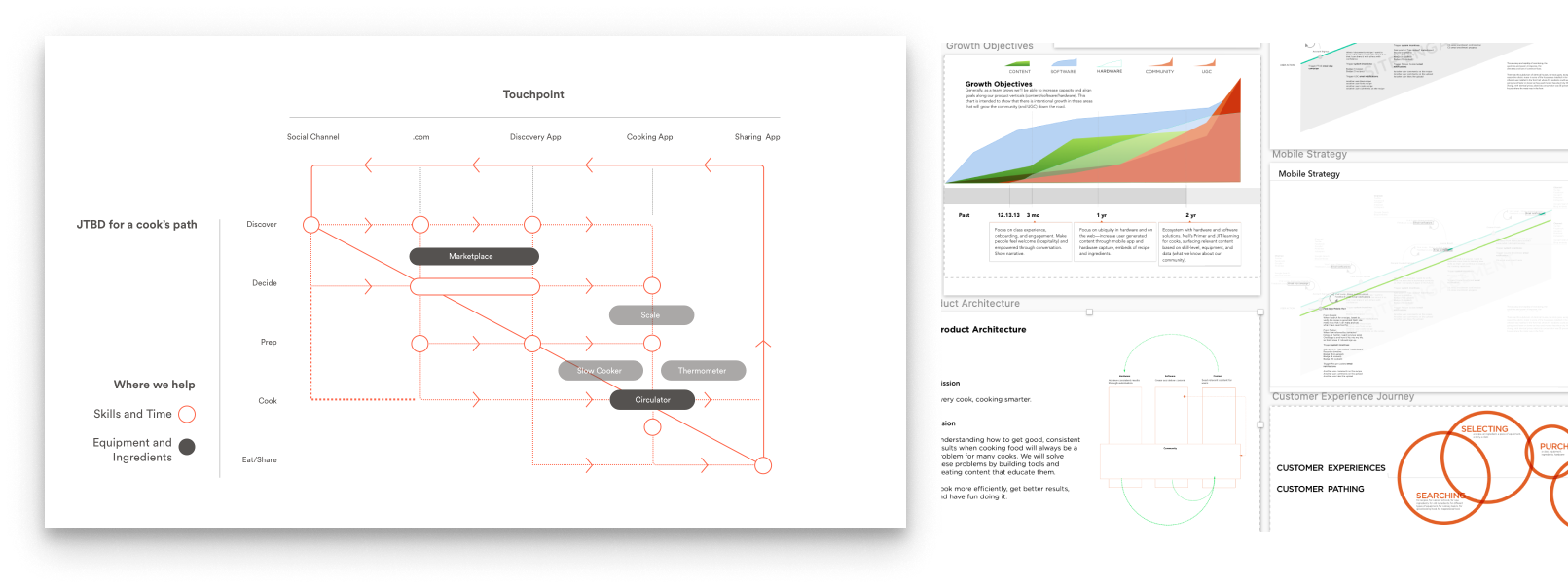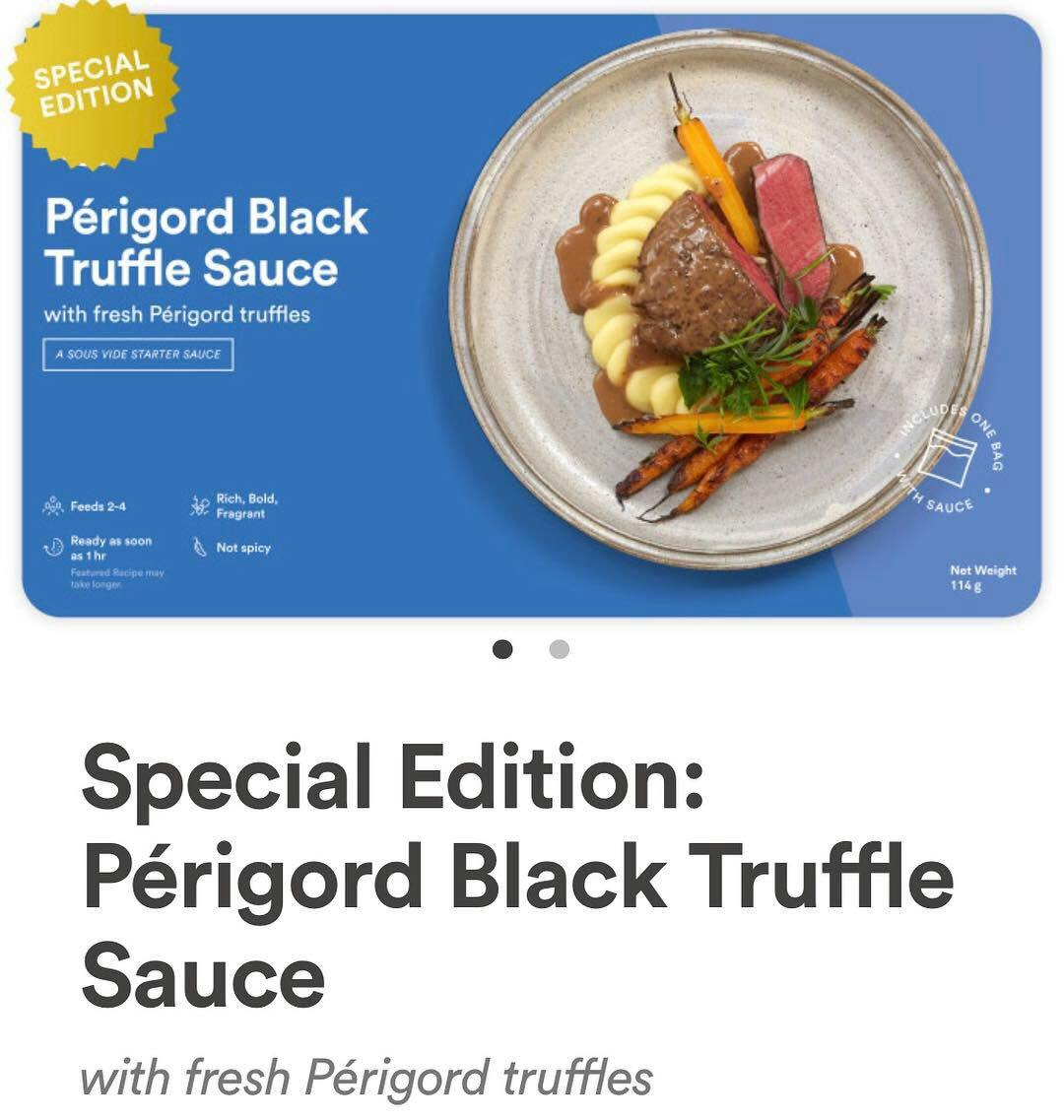Design Case Study: Joule Ready
I worked on Joule Ready for my last 2.5 years at ChefSteps, and here I'll walk through how we defined the business and user problems for the product and how we arrived at the solution of Joule Ready. In between there, I’ll show a little bit about alignment around the product and how design helped keep everyone on the same page in the development and building process.
What is Joule Ready?
First, a little background on ChefSteps: We started out as a cooking content company, and did a lot of work in the first 2 years around building free content for users to eventually monetize classes. At the two-year mark we also decided to embark on a path that included hardware. The piece of hardware we started developing at the time was a sous vide circulator. I helped with that all around from hardware to software design to branding and the website, sales, and marketing pages. At a certain point along that journey we realized that we had more gaps that existed for cooks, so we wanted to create a consumable product that would connect with the hardware, software, and content that ChefSteps had already created. It was our idea of a “full-stack” cooking company.
The way Joule Ready worked was that you would get a protein—meat, chicken, fish, or meat-alternatives, and drop it in a sous vide bag that had sauce in it. You’d scan the bag and that would give you the directions to make the food, along with the proper time and temperature (along with something called Visual Donenes™) for the cook. We actually have a couple of patents on this! It’s pretty cool. You choose the doneness and push a button, it sets the cooking temperature and alerts you when it’s done. Easy-peasy.
Defining the Problem
One of the early projects that I did was trying to map out all of the touch points for our users and map out where we could help them. What it came down to was always the caps of skills time equipment and ingredients. Time is always the hardest part, because trying to convince people to value their time cooking had the most competition. This was largely where content came through—Inspiration was the most helpful way to get people to cook. But we wanted to be “full-stack.” We moved from purely educations, to educational plus inspirational. Our equipment was a circulator, and the final leg of the stool was ingredients to cook with.
Forces of Progress
- Probably two years in, had several dozen user interviews at this point
- Mapped the cook’s journey after talking and watching several users
This also solved the recurring revenue model. While content was plentiful, it became a behemoth; hard to create and expensive (of course, this dwarfed hardware, something we learned the hard way). But ingredients were a way to get recurring revenue—We just had to figure out how to make the margins work.
Exploring Solutions
During the next few months we started experimenting. We iterated, tested, learned, and made changes from both the UX side and the business side to learn what was going to work for both sides. We did some pretty strange things that were not unprecedented, but we wanted to learn first-hand why they did or didn't work. I'll go through them briefly below.
Meat Sale
We started with the basics: Protein. We offered meat for sale to all our Joule customers and invited them to come to the ChefSteps space in Pike Place Market. We enticed a lot of folks to come down and hang out, drink some coffee, peruse knives, and get their meat orders fulfilled. We sold a good amount of meat, but more importantly, found out a great way to increase margins on the product: Sous vide upgrades.
About 80% of our meat sales were sous vide upgrades, which meant we vacuum packed the items with herbs, spices, and oil. The cost of materials was small and it gave us a good +20% on margin. We had solved two business problems: Find some way to get recurring revenue in a hardware-based business model and also increase margin on commodity products as the cost of the upgrade for us was pennies on the dollar. We knew this also solved a very specific problem for our users; two, in fact: Time and ingredient scarcity.
Butcher Partners
We then proceeded to the next step trying to achieve a next level of growth, and that was trying to find the right means of distribution. Shipping meat is expensive and hard, so we looked to partner with butchers across the Seattle area and my product partner Brian McCracken made lots of connections and cold-called butchers to strike up deals. We ended up partnering with B&E Meats and Seafood and Double D Meats to create sous vide-ready packs, and we made specific job-to-be-done packages like "Weeknight Dinners" (4 separate dinner proteins packed and ready-to-cook) and "Party Packs" (Burgers and Chicken for a grill party). We even had one called "Mountain of Meat" which we sold quite a few of. It's debatable what JTBD that fit, but it was a social/emotional need for sure.
Butchers were one way to hit that distribution mark, but it was slow-going to get some of those folks on board to sous vide—I know Brian got hung up on more than once, "We don't do that sh*t," they said.
That's where Heritage Meats came in. They ran a MSU (Mobile Slaughter Unit) that ran up and down the I-5 corridor processing meat for ranches across the Pacific Northwest. We thought that partnering with Heritage was sort of a lynchpin for much of the artisan butchery (we didn't bother with commodity meat farms), and it worked for a while. We even sold directly from some of their trucks and met people in parking lots to fulfill orders (yes, it's been done before).
Ultimately, it was still a distribution and margin game at this point, so we threw one last hail-mary with meat....
Pre-cooked meats
Last mile distribution is hard. Transporting perishable goods is hard. In the midst of all this, we started to see all these startups working on gig workers to transport last-mile, so we thought we'd give this a shot—Move directly away from value and focus on quality and convenience. We did this a few times, experimenting with ready-made meats and delivering the food UberEats-style for dinner that evening. Turns out, not really a factor in dinnertime at all. We quickly abandoned this and went back to square one. Ditched the meat all together and just did the upgrade.
Joule Ready Sauces
So we started making sauces in a bag. This solved a lot of problems from the product side: No perishables. Shelf-stable. Cheap to make. Great margin. Easy to ship. Distribution and marketing were the biggest lift.
Fast forward a few months and we had spun up a kitchen in SoDo and bought commercial equipment (after a few months of making and packaging all the sauces in-house at ChefSteps). We ended up making awesome packaging and branding (see Emmett Barton's work for Joule Ready here) and had a distribution plan that started with our massive ChefSteps mailing list. We leveraged all the previous content and started to come back to the advantages that we had: Hardware, Software, and Content all under the same roof. We were able to gain traction on sales very quickly, and found a few different ways to spike sales, including special edition sauces.
This just brought folks back to look at other sauces in addition to selling a special-edition (and even more premium) sauce.
Sure, it all sounds well and great that we had some good successes with Joule Ready, but we had a lot to think about: The Big Job and the Little Job come to mind—We needed to keep people buying the products, and of course, we needed them to use them as well so that they wouldn't just stay stuck in the pantry. The "Ah-ha!" moment was obviously when the actually at the stuff, because are sauces were bomb. We devised a couple of different ways to get people to eat, but if you'll go back to the beginning of the post, you'll remember—Inspiration was the number one way to do this. So we thought of different ways to get people to cook and also to use the sauce. Some of our ideas included recipes for naan (to sell our Tikka Masala) or something called "Sauce 4-ways" which was just different recipes to use the sauce with. It was all good stuff, we just ran out of time.
Outcomes
Pirate metrics were pretty good. Email was a great channel for us, much more lucrative than any other channel, including social (YouTube and Instagram conversions were very scarce). One thing we were keenly aware of was the idea that people were buying out of novelty at first, and if we didn’t get them to use the sauces, then we were going to get stuck in the pantry and repurchases would not happen. That’s when we started really hammering away at content that would hopefully increase sauce consumption. One of the greatest things that I feel like we did was this naan video.
People seemed to love the product and were sad when it went away, too.
So what did I really do?
This was a pretty formative time in my career. I essentially ran the product team and made decisions on what experiments we were running and wading through data to determine how to move forward.
- I ran standups Tuesdays and Thursdays and worked cross-collaboratively with marketing, content, kitchen, logistics, design, and engineering.
- I developed a content strategy plan and metrics of success for the product and content marketing strategy.
- I filled gaps when I needed to, including clearing the way for Emmett to do all the brand and packaging design by doing all the online store design work and even some of the front-end development in Shopify.
- I packed our first batch of sauces and sent them out to customers—Drove them to the post office.
- I led the beta program along with Kristina Voros and we ran extensive testing including "Liking" scores for the food product as well as NPS for each sauce.
I made sure everyone was unblocked and happy with the work they were doing. Picture 14 of us crammed in the room:
All trying to do our individual jobs, together. I could sense stress! I said, "Let's all take a deep breath together!" And we collectively took a giant breath and blew out and I don't know what it was, but I felt like it was a galvanizing moment for all of us. I'm very proud of what we did and even more so the team that we had put together.
What would I do differently?
I would have started with content much sooner and had a steadier cadence of it. And not just videos. A concerted effort with attribution would likely have helped when it came to acquisition and really established the sauces as a staple for Joule users. Integrating the product with the hardware (get free sauces on purchase) were all in our plans.
We had lots of plans to do more, and I think we were well-positioned to do much more with it. C'est la vie! ChefSteps was bought by Breville in April of 2019 and sauces were not in their plans. Sometimes I think about spinning some of this back up, but that is a project for another time. 😀
© Tim SalazarRSS



